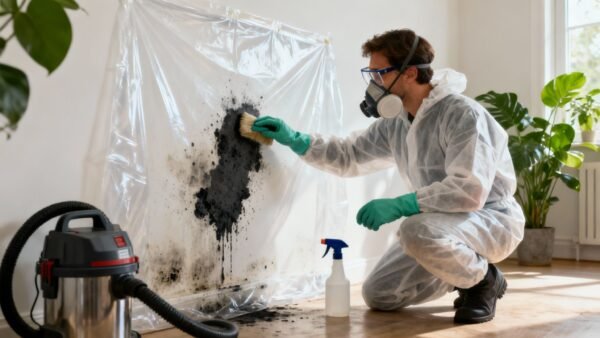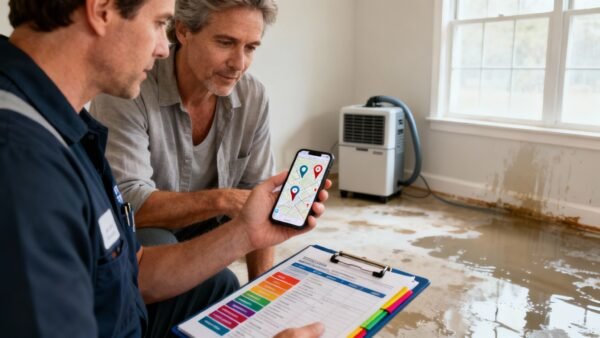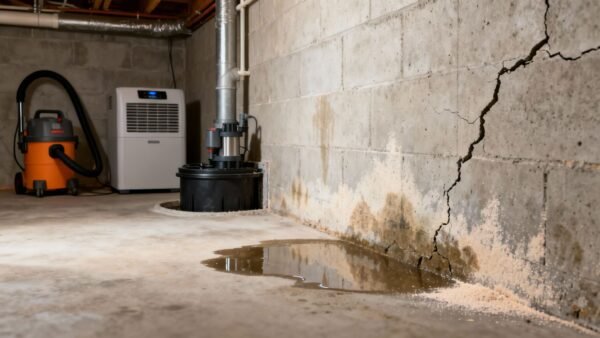When a fire strikes your Los Angeles home, the first few hours are a dizzying mix of shock, fear, and confusion. What you do in this critical window matters immensely, setting the stage for a safe and successful recovery. Your first job in any fire damage and restoration process is simple but non-negotiable: make sure everyone is safe and accounted for. Only then should you pick up the phone to call your insurance agent and a certified restoration company.
Dealing with the aftermath of a fire, whether it’s a small kitchen flare-up in a Sherman Oaks condo or extensive damage from a wildfire near the hills of Calabasas, requires immediate and expert attention.
Need immediate help? Don’t wait. Call Onsite Pro Restoration now for a 24/7 emergency response.
Your First Steps After a Home Fire
It’s completely normal to feel overwhelmed. Having a clear set of priorities can help you cut through the chaos and regain a sense of control. The initial 24 hours are the most critical. Smart, swift actions can prevent further damage and make the insurance process go much more smoothly. On the flip side, making the wrong move—like rushing back inside for a sentimental item—can lead to serious injury and create major headaches for your claim.
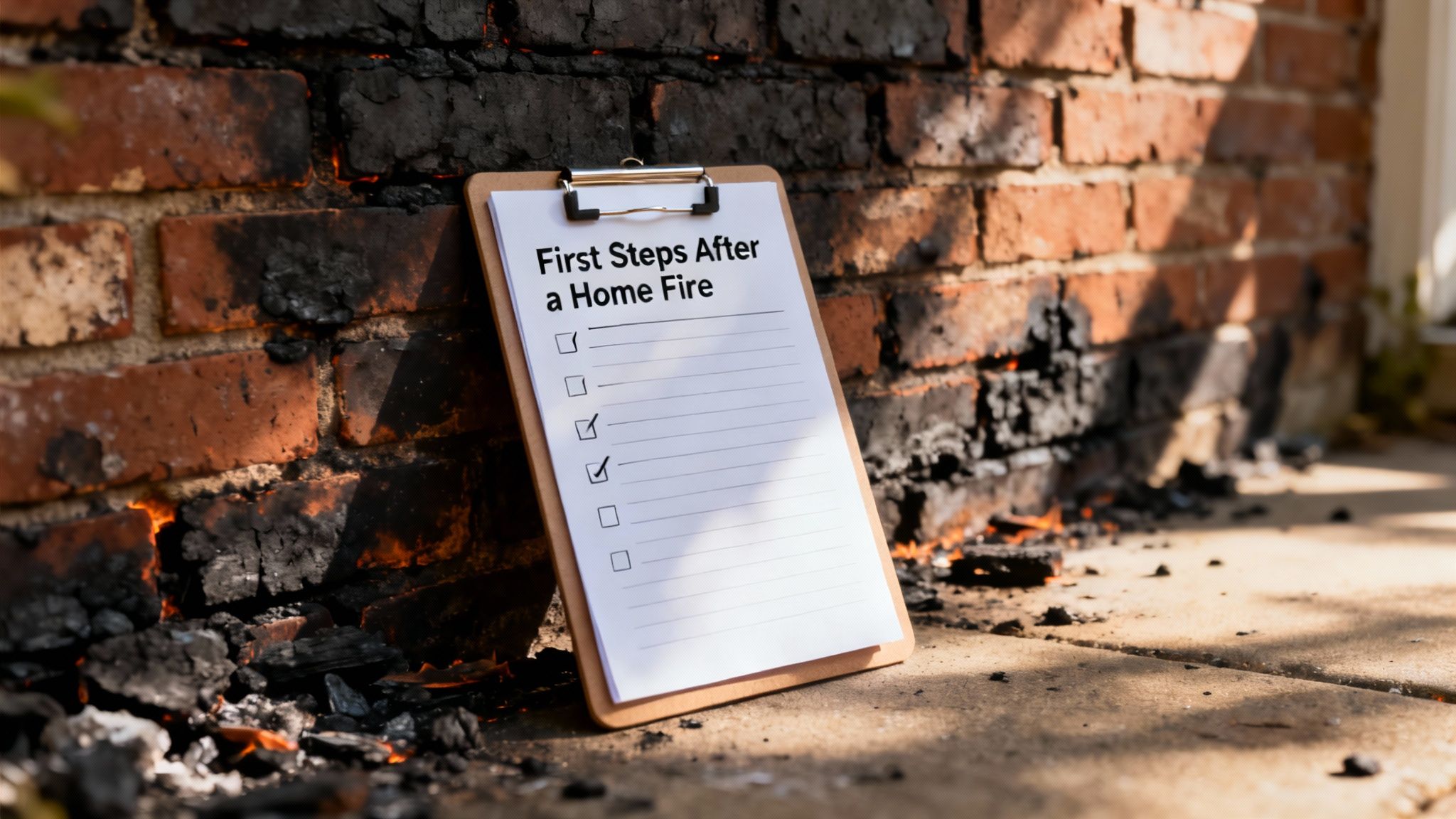
Prioritize Safety Above All Else
Let’s be crystal clear: nothing is more important than your family’s well-being. Once you’re safely outside, stay outside. Do not even think about re-entering the building until a fire official gives you the explicit all-clear. Even after the flames are extinguished, the structure can be dangerously unstable. Worse, invisible hazards like toxic gases, live wires, and compromised floors are everywhere.
Making the Essential Calls
After you’ve confirmed everyone is safe, it’s time to start the recovery process. This means reaching out to the key people who will guide you through the next steps of your fire damage and restoration journey.
- Contact Your Insurance Company: Call your agent immediately. The sooner you report the fire, the sooner they can open your claim. They’ll walk you through what your policy covers, including critical funds for temporary housing if your home is unlivable.
- Call a Certified Restoration Professional: Get a specialized fire damage company on the line. They can dispatch a team right away to assess the damage and, most importantly, secure your property. This includes boarding up broken windows and doors to protect against weather and vandalism.
Crucial Reminder: Whatever you do, don’t start cleaning. Wiping soot off a wall or trying to shampoo a smoky carpet seems productive, but it’s a huge mistake. Without the right techniques and chemicals, you can permanently embed stains and spread contaminants, making a professional’s job much harder—and more expensive.
What Not to Do After a Fire
Knowing what to avoid is just as critical as knowing what to do. Here are the big mistakes to steer clear of:
- Don’t Re-enter the Building: It bears repeating. Wait for official clearance from the fire department.
- Don’t Use Utilities: Do not flip a light switch, turn on the gas, or run any water until a professional has inspected and cleared your systems.
- Don’t Clean Anything: Even just touching soot-covered surfaces can be a problem. The natural oils on your hands can react with soot, causing permanent etching and staining.
By following these first few steps, you’re building a solid foundation for an effective fire damage and restoration process and putting yourself on the fastest path back to normal.
Understanding the True Impact of Fire Damage
After the fire trucks leave, it’s natural to focus on what you can see—the charred furniture and blackened walls. But the truth is, the most stubborn and dangerous threats a fire leaves behind are often invisible. The real scope of fire damage and restoration goes far beyond the initial burn marks, creeping into almost every part of your property.
Think of smoke and soot like microscopic, oily invaders. Propelled by intense heat, these tiny particles travel through your home’s HVAC system, settling in rooms that the flames never even touched. They worm their way deep into porous materials like drywall, carpets, and upholstery, causing widespread contamination that’s impossible to just wipe away.
The Unseen Layers of Destruction
The damage doesn’t stop with soot, either. The water used to extinguish the fire introduces a whole new problem: secondary water damage. All that moisture soaks into your home’s structure, leading to swelling, warping, and—if not addressed immediately—dangerous mold growth in as little as 24 to 48 hours.
On top of that, a modern house fire is a chemical nightmare. When plastics, electronics, and synthetic fabrics burn, they release a nasty cocktail of toxic and acidic residues. These chemicals don’t just pose serious health risks; they actively corrode metal fixtures, stain glass, and etch appliances, causing permanent damage. For a closer look at this specific problem, check out our complete guide on smoke damage restoration.
To really get a handle on what you’re up against, it helps to break down the different kinds of damage a fire can cause. Each type requires a unique approach to fix it right.
Types of Fire and Smoke Damage
| Damage Type | Primary Cause | Key Restoration Challenge |
|---|---|---|
| Direct Flame Damage | Direct contact with fire. | Charred materials often require complete removal and structural replacement. |
| Soot and Smoke Damage | Airborne combustion byproducts. | Soot is oily and acidic; it embeds in porous surfaces and requires specialized cleaning techniques. |
| Secondary Water Damage | Water from firefighting efforts. | Preventing mold growth and addressing structural swelling or warping from moisture. |
| Chemical Contamination | Burning of synthetic materials. | Neutralizing toxic, corrosive residues that can damage surfaces and pose health risks. |
As you can see, tackling fire damage is a multi-front battle. It’s not just about cleaning up what burned, but also about managing the fallout from smoke, water, and chemicals.
Why Professional Assessment Is Crucial for Fire Damage and Restoration
This tangled mess of heat, smoke, water, and chemical damage is exactly why a professional assessment isn’t just a good idea—it’s essential. Only a trained expert can see the full picture, identifying how far the contaminants have spread and what can realistically be saved.
An expert in fire damage and restoration isn’t just looking at what burned; they are tracing the path of smoke, testing for hidden moisture, and identifying the chemical nature of the soot to apply the correct cleaning agents.
We’ve seen the sheer scale of fire-related devastation right here in our community. The devastating Los Angeles area wildfires in recent years serve as a harsh reminder of how quickly fire can overwhelm entire neighborhoods. The economic impact of these events, as tracked by agencies like FEMA, runs into the billions. This local context drives home why a thorough, professional response is so critical for any fire, big or small. It’s the only way to head off long-term structural problems and financial disaster.
The Professional Fire Damage Restoration Process
Getting your property back on its feet after a fire isn’t a one-and-done job. It’s a carefully planned process, handled by pros who know exactly what to look for. Professional fire damage and restoration is a methodical sequence designed to tackle every layer of damage—the obvious, the hidden, and everything in between—to safely bring your property back to how it was before the fire.
It all starts the second a certified team walks through the door. They don’t just jump into cleaning; they start with a plan. Their first job is to understand the true scope of the fire’s impact, which is almost always worse than what you can see with your own eyes.
Our team follows a strict, industry-approved process to ensure your property is restored correctly.
Step 1: Initial Assessment and Property Security
The very first priority is a full-blown inspection. A project manager will walk through your home or business, figuring out the extent of the fire, smoke, and water damage. They come armed with specialized tools to test how far soot has traveled into hidden spaces and to measure moisture levels in walls and floors left behind by the firefighters.
At the same time, the team gets to work securing your property. This isn’t optional; it’s critical. Actions include:
- Boarding Up: Covering any broken windows and compromised doors to keep the property secure from intruders.
- Tarping Roofs: If the roof is damaged, they’ll throw up tarps to protect the structure from rain and weather.
- Establishing a Safe Zone: They’ll identify and rope off any areas that are structurally unstable.
Taking these immediate steps is crucial to stop any further damage and prevent liability issues while the full restoration plan is being mapped out.
Step 2: Water Removal and Structural Drying
You can’t even think about cleaning soot until you’ve dealt with the water. The water used to put out the fire is a huge source of secondary damage, creating the perfect conditions for mold to start growing within just 24-48 hours.
Professionals don’t mess around here. They bring in powerful truck-mounted extractors and submersible pumps to get rid of standing water fast. Once the bulk of the water is gone, they strategically place industrial-grade air movers and dehumidifiers all over the property. This creates a powerful drying vortex that pulls trapped moisture right out of porous materials like wood, drywall, and insulation.
This infographic shows just how interconnected fire, soot, and water damage really are—and why pros have to tackle them in a specific order.
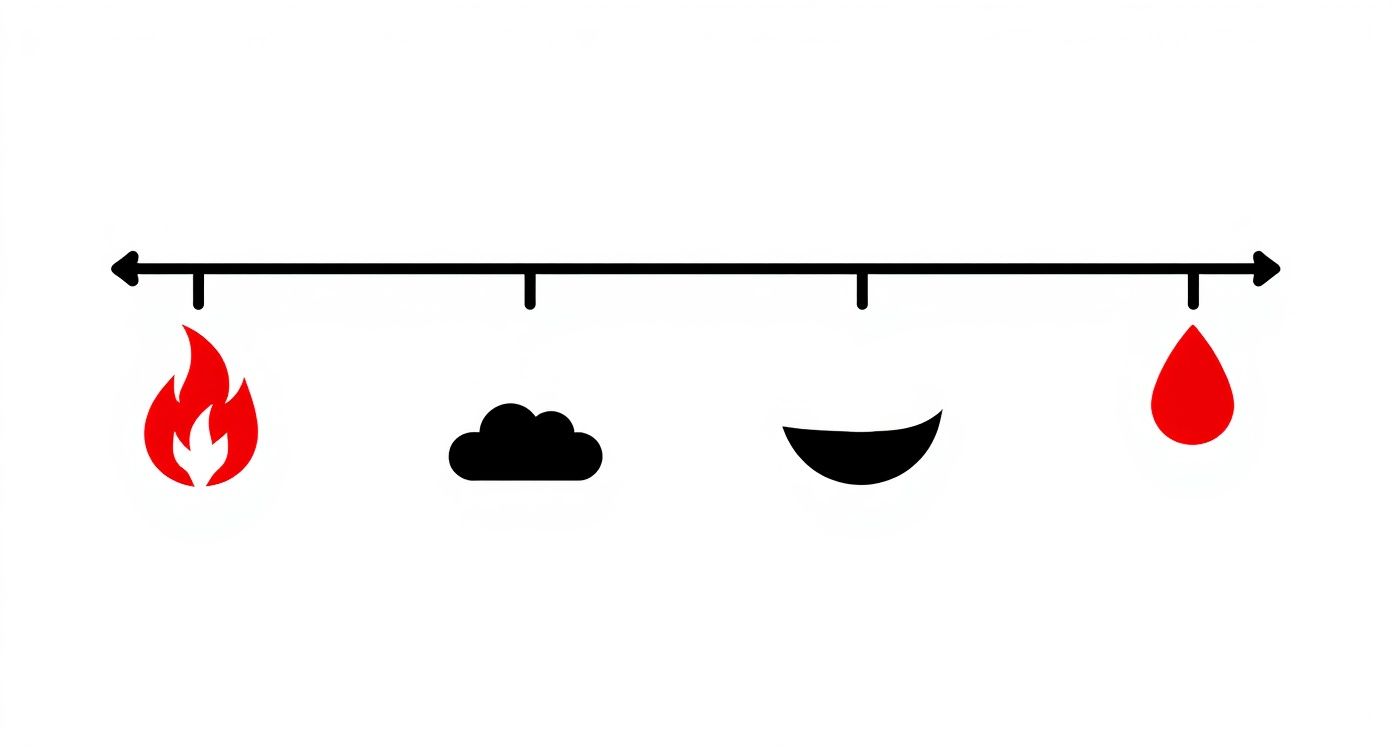
As you can see, the initial fire is just the starting point. The way soot spreads and water gets introduced creates complex layers of damage that demand a specialized, step-by-step response.
Step 3: Soot and Smoke Removal
Once every last bit of moisture is gone, the real dirty work begins: getting rid of soot and smoke residue. This is a meticulous process. Soot is oily, acidic, and stubborn. Using the wrong cleaning methods will just smear it and push it deeper into surfaces, causing stains that you’ll never get out.
Expert Insight: Not all smoke is the same. Different materials burning (like wood versus plastic) create different types of soot—wet, dry, or even protein-based from kitchen fires. A pro has to identify the type of soot to pick the right cleaning agent, like specialized chemical sponges that lift soot off a surface without smearing it.
This phase means cleaning every single affected surface, from ceilings and walls right down to your personal belongings. It also usually means a deep clean of your HVAC system to make sure soot particles don’t get blown all over your house the first time you turn the heat or AC back on.
Step 4: Cleaning, Sanitizing, and Odor Removal
With the soot gone, the next step is a deep clean and sanitization. That lingering smoke smell is notoriously difficult to eliminate because it seeps into everything porous. Technicians use heavy-duty equipment like thermal foggers or ozone generators to neutralize odors that are trapped deep inside materials. Every salvageable item is cleaned, and antimicrobial treatments are applied to make sure mold doesn’t stand a chance.
Finally, the job shifts from cleanup to rebuilding. This could be something as simple as laying new carpet and repainting walls, or it could be as extensive as reconstructing entire sections of your home. This is the last leg of the journey, where your property finally starts to feel like yours again. To see exactly how our certified team manages this entire process, you can learn more about our comprehensive fire damage restoration services.
How to Navigate Your Insurance Claim
Wrestling with an insurance claim can feel as overwhelming as dealing with the fire itself. But with a methodical approach, you can get through this critical step and make sure you receive the full compensation you’re owed.
The whole game is about thorough documentation and clear, consistent communication, right from the very start.
In the immediate aftermath, your smartphone is your single most important tool. Before a single thing is touched or moved, you need to document everything. Take hundreds of photos and videos. Get shots from every angle, capturing wide views of each room and then zooming in for close-ups of specific damage. This visual evidence is the most powerful proof you have of your property’s condition right after the fire.
Documenting Your Losses
Once you’ve captured the structural damage, it’s time to create a detailed home inventory list. This is your comprehensive catalog of every single item that was damaged or destroyed in the fire.
You have to be incredibly specific here. Instead of just writing “toaster,” you need to list it as “Breville 4-slice stainless steel toaster, model BTA840XL.”
- List Everything: Go room by room. Log all the furniture, electronics, clothing, kitchenware—even the small decor items.
- Find Proof of Value: For your bigger ticket items, dig up any receipts, credit card statements, or even original boxes that can help establish their value.
- Don’t Forget the Small Stuff: The cost of replacing things like spices, toiletries, and towels adds up incredibly fast. Make sure they’re on your list.
This detailed inventory is the foundation of a successful fire damage and restoration claim. It gives your adjuster the exact information they need to calculate your settlement accurately.
Understanding Key Insurance Terms
As you start talking with your insurance adjuster, you’re going to hear some specific terms that directly affect how you get paid. Getting a handle on this language is crucial for managing your own expectations and your financial recovery.
Crucial Distinction: The difference between ACV and RCV can easily mean thousands of dollars in your final settlement. Always clarify which type of coverage you have and ask your restoration company how they can help document costs to satisfy your policy’s requirements.
The two most important terms you’ll encounter are:
- Actual Cash Value (ACV): This is the value of your damaged property minus depreciation. Think of it as what your five-year-old sofa is worth today, not what you paid for it new.
- Replacement Cost Value (RCV): This coverage pays the full cost to replace your damaged property with a new item of similar kind and quality, without any deduction for depreciation.
Many policies will pay out the ACV first. Then, once you’ve actually replaced the item and can show a receipt, they’ll release the rest of the funds. This process can be tricky, and understanding the typical insurance claim timeline will give you a much clearer picture of what to expect. This knowledge empowers you to work more effectively with both your adjuster and your restoration team.
How to Choose the Right Los Angeles Restoration Company
After a fire, the restoration company you hire is easily the most important partner you’ll have in the recovery process. This isn’t a decision to rush with a quick online search. Picking the right team for your fire damage and restoration means finding licensed, certified pros who know how to manage the entire job—from cleanup to working with your insurance adjuster.
Your very first move should be to check their credentials. Don’t even consider a company that isn’t fully licensed and insured to work in your area. Beyond that, the real benchmark is IICRC (Institute of Inspection, Cleaning and Restoration Certification) certification. This is the gold standard, proving their technicians are trained on the latest, safest, and most effective methods in the industry.
Vet Their Experience and Reputation
When you’re looking at potential companies, get specific. Ask them directly about their experience with fire damage and restoration. A company that mostly handles water leaks might not have the specialized skills needed to tackle complex soot, smoke, and odor issues.
Of course, check online reviews, but also ask for references from recent fire-related jobs. Hearing from another homeowner who went through this is invaluable. The process of checking credentials and comparing quotes is critical, just like with any major home repair. These tips for selecting a reliable contractor offer some great general advice that applies here, too.
Ask the Right Questions
Before you sign anything, you need clear answers. A trustworthy company will be transparent and won’t hesitate to give you the details you need.
Here are a few non-negotiables to ask:
- Do you work directly with insurance companies? A team that knows how to navigate the claims process is a huge weight off your shoulders.
- What is your projected timeline? Things can change, but they should be able to give you a reasonable estimate upfront.
- Can you handle both mitigation and reconstruction? Sticking with one company for both the cleanup and the repairs makes the entire process infinitely simpler.
The increasing intensity of California’s fire seasons underscores the importance of having competent professionals ready to help at a moment’s notice.
Key Takeaway: A reputable company will never pressure you into signing a contract on the spot. They should offer a detailed, written estimate and give you the time to make an informed decision.
Choosing the right partner isn’t just about cleaning up the mess; it’s about rebuilding your life with confidence. If you’re in the Los Angeles area, our detailed guide can help you navigate the local options: choose a restoration company in Los Angeles.
Proactive Steps for Future Fire Prevention
After your home is finally restored, the last thing you want is to go through another fire. The experience of a fire damage and restoration project is a powerful motivator for prevention. It’s not about living in fear—it’s about taking smart, proactive steps to make sure it never happens again.
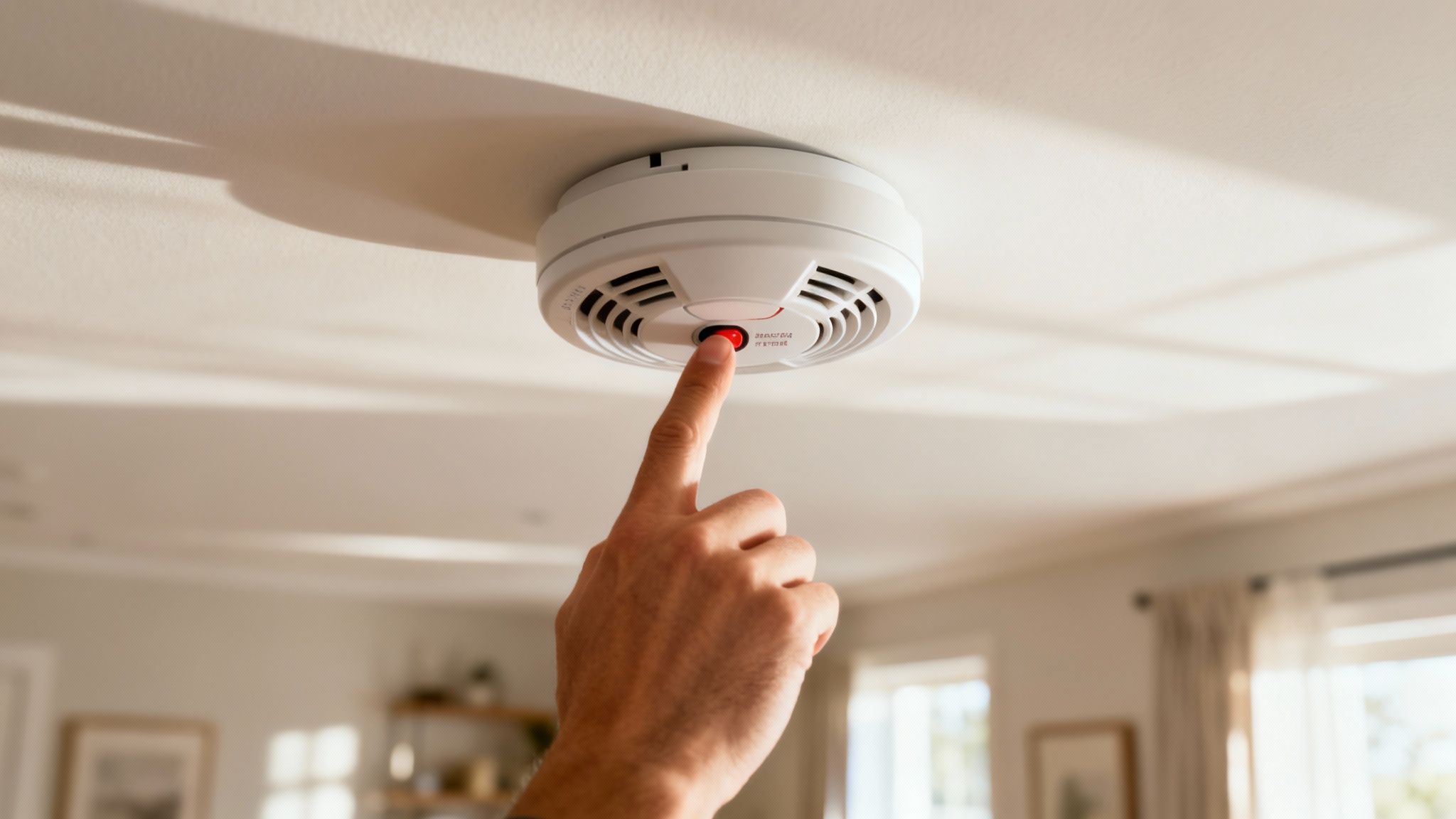
Reinforce Your Electrical and Appliance Safety
A surprising number of house fires start with something as simple as a bad cord or a clogged dryer vent. A few routine checks can eliminate these common risks.
- Inspect Cords: Regularly check electrical cords for any signs of fraying or cracking. You should also never run cords under rugs, which can trap heat and create a serious hazard.
- Avoid Overloading Outlets: Use power strips that have built-in surge protectors. It’s a simple rule: don’t plug too many high-power appliances into a single outlet.
- Maintain Appliances: Keep your appliances clean and running efficiently. Clean the lint trap in your dryer after every single use, and make sure refrigerators and freezers have enough space around them for proper airflow.
If you’re looking for more ways to protect your home, a comprehensive guide on how to prevent house fires offers some excellent, in-depth tips.
Create Defensible Space Around Your Home
For homeowners in wildfire-prone regions like much of Southern California, “defensible space” is non-negotiable. This just means managing the plants, trees, and other vegetation around your home to slow a fire’s approach. With fire seasons getting longer and more intense, this is more critical than ever.
The trend toward hotter, more destructive fires is a clear signal that proactive measures aren’t just a good idea—they’re essential for protecting your property in vulnerable areas.
Key Takeaway: Prevention is the final, most important step in the restoration journey. Simple habits like maintaining appliances and managing landscaping can transform a past crisis into lasting security for your home.
FAQs About Fire Damage and Restoration in Los Angeles
Q: How long does the fire damage restoration process usually take?
A: It varies significantly based on the extent of the damage. A minor kitchen fire might take a few days to a week, whereas a major fire involving structural damage and extensive smoke penetration throughout a Los Angeles home could take several months to fully restore.
Q: Can I clean up soot and smoke damage myself?
A: We strongly advise against DIY cleanup. Soot is acidic, oily, and contains toxic particles. Household cleaners can smear soot, permanently setting stains into surfaces. Professionals use specialized chemical sponges, cleaning agents, and equipment like thermal foggers to safely and effectively remove contaminants and odors.
Q: Does my homeowners’ insurance cover all costs for fire damage and restoration?
A: Most standard homeowners’ policies cover fire damage, but the exact coverage depends on your policy limits and deductible. It’s crucial to review your policy and work closely with your restoration company, who can document everything to help ensure your claim is processed accurately.
Q: What is the first thing I should do if my house catches fire?
A: Your absolute first priority is to ensure everyone gets out of the house safely. Once you are safe and have called 911, your next calls should be to your insurance company to start the claim process and to a certified fire damage restoration company to secure the property and begin assessment.
Dealing with the aftermath of a fire is incredibly complex, but you don’t have to face it alone. The certified experts at Onsite Pro Restoration are here 24/7 to guide you through every single step of the recovery process. Give us a call now for a free, no-obligation assessment.


